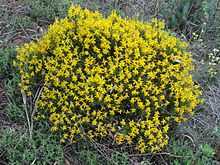Genistoids
| Genistoids | |
|---|---|
 | |
| Genista hirsuta | |
| Scientific classification | |
| Kingdom: | Plantae |
| (unranked): | Angiosperms |
| (unranked): | Eudicots |
| (unranked): | Rosids |
| Order: | Fabales |
| Family: | Fabaceae |
| Subfamily: | Faboideae |
| (unranked): | Meso-Papilionoideae |
| (unranked): | Genistoids Wojciechowski et al. 2004[1][2] |
| Tribes[3][4] | |
| |
| Synonyms | |
| |
The Genistoids are one of the major radiations in the plant family Fabaceae. Members of this phylogenetic clade are primarily found in the Southern hemisphere.[1][3][4] Some genera are pollinated by birds.[3] The genistoid clade is consistently resolved as monophyletic in molecular phylogenetic analyses.[1][3][4][7][8][9][10][11] It is estimated to have arisen 56.4 ± 0.2 million years ago (in the Paleocene).[8] A node-based definition for the genistoids is: "the MRCA of Poecilanthe parviflora and Lupinus argenteus."[1] One morphological synapomorphy has been tentatively identified: production of quinolizidine alkaloids.[1][12][13][14] Some genera also accumulate pyrrolizidine.[3][4] A new genus, to be segregated from Clathrotropis, has also been proposed to occupy an undetermined position within the genistoid clade.[3][4]
Core Genistoids
The core genistoids, also known as the genistoids sensu stricto, comprise most of the tribes of the genistoids sensu lato, and are found mainly in Africa and Eurasia.[4] This subclade is also consistently resolved as monophyletic.[1][3][4][5][7][8][9] A node-based definition for the core genistoids is: "the MRCA of Bolusanthus speciosus and Spartium junceum.[1]
References
- ↑ 1.0 1.1 1.2 1.3 1.4 1.5 1.6 Wojciechowski MF, Lavin M, Sanderson MJ. (2004). "A phylogeny of legumes (Leguminosae) based on analysis of the plastid matK gene resolves many well-supported subclades within the family". Am J Bot 91 (11): 1846–1862. doi:10.3732/ajb.91.11.1846. PMID 21652332.
- ↑ Wojciechowski MF. (2013). "Towards a new classification of Leguminosae: Naming clades using non-Linnaean phylogenetic nomenclature". S Afr J Bot 89: 85–93. doi:10.1016/j.sajb.2013.06.017.
- ↑ 3.0 3.1 3.2 3.3 3.4 3.5 3.6 Cardoso D, de Queiroz LP, Pennington RT, de Lima HC, Fonty É, Wojciechowski MF, Lavin M. (2012). "Revisiting the phylogeny of papilionoid legumes: new insights from comprehensively sampled early-branching lineages". Am J Bot 99 (12): 1991–2013. doi:10.3732/ajb.1200380.
- ↑ 4.0 4.1 4.2 4.3 4.4 4.5 4.6 Cardoso D, Pennington RT, de Queiroz LP, Boatwright JS, Van Wyk B-E, Wojciechowski MF, Lavin M. (2013). "Reconstructing the deep-branching relationships of the papilionoid legumes". S Afr J Bot 89: 58–75. doi:10.1016/j.sajb.2013.05.001.
- ↑ 5.0 5.1 Crisp MD, Gilmore S, Van Wyk B-E. (2000). "Molecular phylogeny of the genistoid tribes of papilionoid legumes". In Herendeen PS, Bruneau A. Advances in Legume Systematics, Part 9. Royal Botanic Gardens, Kew. pp. 249–276. ISBN 184246017X.
- ↑ Polhill RM. (1981). "Papilionoideae". In Polhill RM, Raven PH. Advances in Legume Systematics, Parts 1 and 2. Royal Botanic Gardens, Kew. pp. 191–208. ISBN 9780855212247.
- ↑ 7.0 7.1 LPWG [Legume Phylogeny Working Group] (2013). "Legume phylogeny and classification in the 21st century: progress, prospects and lessons for other species-rich clades". Taxon 62 (2): 217–248. doi:10.12705/622.8.
- ↑ 8.0 8.1 8.2 Lavin M, Herendeen PS, Wojciechowski MF. (2005). "Evolutionary rates analysis of Leguminosae implicates a rapid diversification of lineages during the tertiary". Syst Biol 54 (4): 575–94. doi:10.1080/10635150590947131. PMID 16085576.
- ↑ 9.0 9.1 McMahon MM, Sanderson MJ. (2006). "Phylogenetic supermatrix analysis of GenBank sequences from 2228 papilionoid legumes". Syst Biol 99 (12): 1991–2013. doi:10.3732/ajb.1200380.
- ↑ Pennington RT, Lavin M, Ireland H, Klitgaard B, Preston J, Hu J-M. (2001). "Phylogenetic relationships of basal papilionoid legumes based upon sequences of the chloroplast trnL intron". Syst Bot 55 (5): 818–836. doi:10.1043/0363-6445-26.3.537.
- ↑ Doyle JJ, Doyle JL, Ballenger JA, Dickson EE, Kajita T, Ohashi H. (1997). "A phylogeny of the chloroplast gene rbcL in the Leguminosae: taxonomic correlations and insights into the evolution of nodulation". Am J Bot 84 (4): 541–554. doi:10.2307/2446030. PMID 21708606.
- ↑ Kinghorn AD, Hussain RA, Robbins EF, Balandrin MF, Stirton CH, Evans SV. (1988). "Alkaloid distribution in seeds of Ormosia, Pericopsis and Haplormosia". Phytochemistry 27 (2): 439–444. doi:10.1016/0031-9422(88)83116-9.
- ↑ Van Wyk B-E. (2003). "The value of chemosystematics in clarifying relationships in the Genistoid tribes of papilionoid legumes". Biochem Syst Ecol 31 (8): 875–884. doi:10.1016/S0305-1978(03)00083-8.
- ↑ Wink M, Mohamed GIA. (2003). "Evolution of chemical defense traits in the Leguminosae: mapping of distribution patterns of secondary metabolites on a molecular phylogeny inferred from nucleotide sequences of the rbcL gene". Biochem Syst Ecol 31 (8): 897–917. doi:10.1016/S0305-1978(03)00085-1.